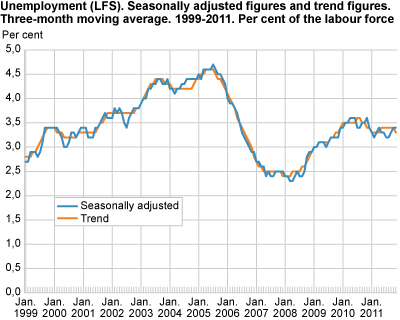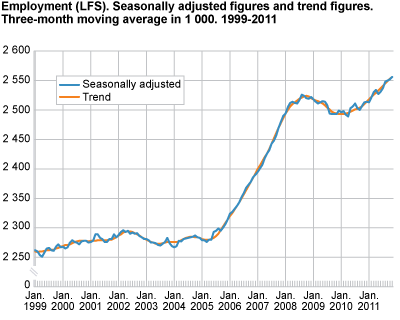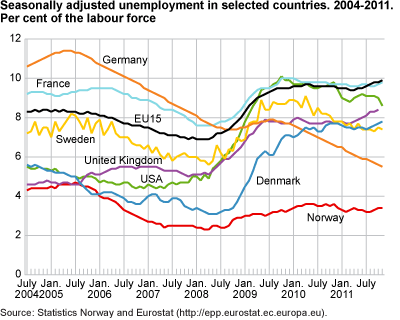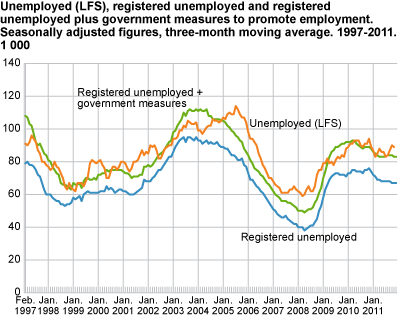Content
Published:
This is an archived release.
Stable labour market
From August to November 2011, there were only minor changes in employment and unemployment. In November, the unemployment was 3.4 per cent of the labour force.
Adjusted for seasonal variations, there were 5 000 more unemployed persons in November (average October-December) than in August (average July-September) last year. The increase is within the error margin of the Labour Force Survey (LFS). A total of 89 000 persons were unemployed in November 2011.
In comparison, the number of registered unemployed persons with the Labour and Welfare Administration (NAV) decreased by 1 000 persons during the same period. These figures have also been adjusted for seasonal variations.
|
The labour force is the total of employed and unemployed between 16-74 years of age. From August to November, employment increased by 7 000 persons and unemployment increased by 5 000 persons. This gives an increase in the labour force of 12 000 persons. Coherence between the conceptsUnemployed + Employed = Labour force Labour force + Outside the labour force = Population |
Stable employment
The seasonally-adjusted figures show an increase in employment of 7 000 persons from August to November. This is within the error margin of the LFS.
Reduced unemployment in the USA
In the USA, unemployment decreased to 8.6 per cent in November last year. This was down 0.5 percentage points compared to August. In the EU15, which is made up of the EU countries prior to the expansions in 2004 and 2007, the unemployment rate increased from 9.7 per cent in August to 9.9 per cent in November. France was one of the EU countries where the unemployment increased during this period, while Germany took another direction. In France, the unemployment rate in November was 9.8 per cent, up 0.2 percentage points since August. In Germany it was 5.5 per cent, down 0.3 percentage points.
The unemployment rate in Sweden was 7.4 per cent in November last year, unchanged from August. In Denmark, 7.8 per cent of the labour force was unemployed in November, up 0.3 per cent compared to August. All figures refer to seasonally-adjusted data from Eurostat .
Employment and unemployment figures include permanent residentsThe LFS only includes persons who are registered as residents in the population register. Persons working in Norway who are not registered as permanent residents or who are planning to stay for less than six months are not included in the employment figure in the LFS. If these people lose their job, it does not count as a fall in employment or a rise in unemployment. In national accounts figures (NR), employed non-residents are included in the employment figure as long as they work in an establishment in Norway. If employment decreases in this group it will count as a fall in employment in NR. Statistics Norway publishes separate figures for all registered non-residents once a year. See short-term immigrants . |
Uncertain figuresThe purpose of making seasonal adjustments is to describe the development over the last year, corrected for seasonal variations. In order to reduce uncertainty, the published series are three-month moving averages of the seasonally-adjusted figures. However, uncertainty means that sampling errors must be considered when interpreting the figures from the LFS. We normally compare the latest non-overlapping three-month periods. An overview of sampling errors in the LFS can be found in “ About the statistics ”, chapter 5, section 3. Quarterly LFS figures, not seasonally adjusted, are presented in a separate article . |
RevisionsThe complete time series is re-estimated each month, and this may cause some adjustments of previously published figures. See Revisions for more information . Interviews that arrive late are included in the LFS the following month. This applies to the first two months in each quarter. |
Tables:
The statistics is published with Labour force survey.
Contact
-
Arbeidsmarked og lønn
E-mail: arbeidsmarked@ssb.no
-
Erik Herstad Horgen
E-mail: erik.horgen@ssb.no
tel.: (+47) 93 08 68 62




